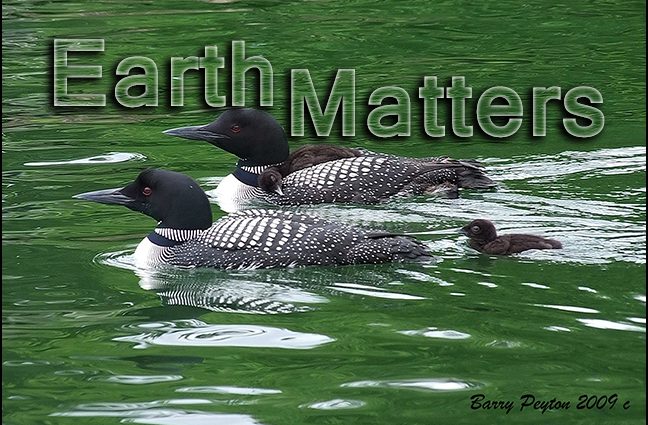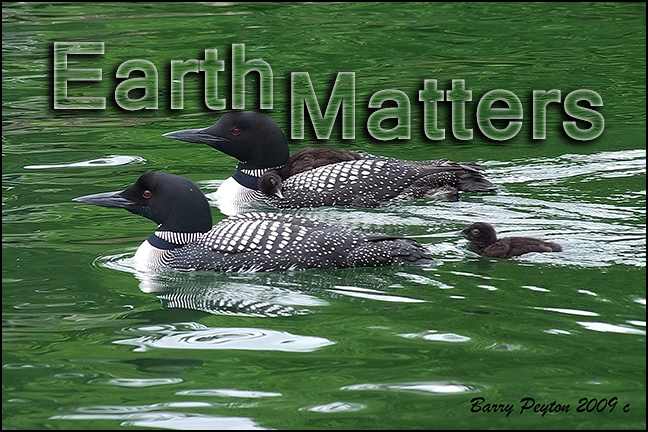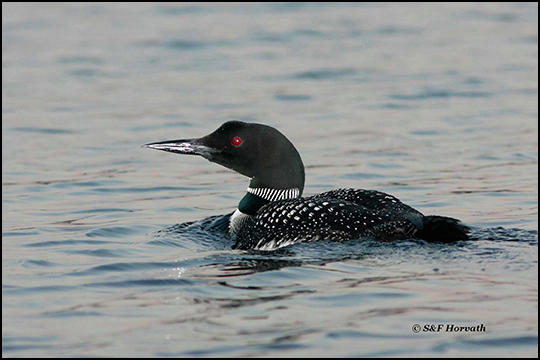CFN – For all Canadian Cottage goers and summer water seekers the sight and sounds of the Common Loon lift the spirit and add that special something to a retreat spent away from the ‘day to day’ in our down-time spent near the water. The soul stirring call of Canada’s Iconic Loon is experiencing challenges according to recent news from Bird Studies Canada.
Bird Studies Canada’s new report The Canadian Lakes Loon Survey 1981-2012 reveals worrisome trends for the Common Loon, an iconic species. Pollution (in the form of mercury and acid precipitation) is the suspected cause.
Currently Common Loon pairs are successfully producing enough chicks to maintain a stable population. Unfortunately, Bird Studies Canada’s research shows that their reproductive success (defined as the annual number of young raised to six weeks of age) has significantly declined since 1992. And the trends indicate that even worse news may be around the corner. If the current rate of decline continues, Common Loon numbers are expected to begin decreasing within two decades.
“We are approaching the tipping point. Annual reproductive success may soon drop below the minimum level required for these birds to sustain their numbers,” says Bird Studies Canada scientist Dr. Doug Tozer, the lead author of the report.
“Because 95% of the world’s Common Loons breed in our country, Canadians have a critical role to play in monitoring and conserving loon populations.”
Mercury and acid precipitation affect lake health and directly impair loon reproductive success. The burning of fossil fuels (e.g., in cars and at coal-fired power plants) causes mercury and acid emissions. From the air, these pollutants make their way into lakes. Common Loons’ high position in the food chain makes them powerful indicators of lake health and especially pollution levels. Higher mercury levels make loons slower, and affect their behaviour. Adults with higher mercury spend less time collecting food for chicks and defending breeding territories. Chicks have compromised immune systems and are less able to avoid predators. Meanwhile on lakes with higher acidity, fish are less abundant and loons produce fewer young.
Individuals can make a difference by supporting loon and lake research and conservation, and participating in Bird Studies Canada’s Citizen Science programs. The results also support further action to reduce harmful emissions from combustion of fossil fuels.
Findings are based on three decades of research by Bird Studies Canada scientists and volunteer surveyors. Over 3000 Citizen Scientists and Bird Studies Canada members contributed their time, data, and support to make this research possible. More detailed analysis can be found in the paper Common Loon Reproductive Success in Canada, published this spring in Avian Conservation & Ecology.
Bird Studies Canada’s Canadian Lakes Loon program has been tracking Common Loon reproductive success at the national level for 20 years (and for 32 years in Ontario). Bird Studies Canada advances the understanding, appreciation, and conservation of wild birds and their habitats. BSC is Canada’s national charity for bird research and conservation.
Images provided by Bird Studies Canada. Lone loon crafted by Sandra and Frank Horvath, loon family image crafted by Barry Peyton.
.
Your commentary is encouraged and always welcome below or to earthmatters@jmilner.com




My husband and I always walk in the park here in Ottawa and we have noticed a great deal less birds than normal and that is “all birds” and not just one species. We have been talking about this very subject for some time now. On Monday we went to the Upper Canada Bird Sanctuary in Ingleside and we noticed very few birds compared to past years and yes it has to do with the pollution. Here in Ottawa there are so many cars that it is deafening. My daughter and I will be going out for a walk together soon and we just dread the traffic – so mighty noisy and polluted to the hilt. I sure do feel it coming home after a walk and using the elevator is hard to get one’s breath. If creatures die like what is happening and the insects as well then we as a human species are done with as well.
canada’s national report from 2012 states: In recent decades, most bird groups in the Lower Great Lakes–St. Lawrence region have increased. On average, all species are up by 20%.
I don’t believe in any government statistics because they all lie. I believe in what I see on a daily basis and the bird population is down – way down. There were more birds last year and they have been declining throughout the years but this year is really down. Governments never tell the people the truth and as a former government employee I can vouch for that.
Jules, the numbers come from a global group of scientists that work together. Not all the numbers for all birds are good. It’s a regional issue. I’m a birder and bird lover. In fact, before this story was “copied and pasted” from one of the bulletins I receive, I was also thinking about our beloved loons. But if you look at this public relations release, it’s to raise money…money that I agree would be well spent doing more research. But if you look at the scientific study that this communique inspired, the message is (to quote from above): “Currently Common Loon pairs are successfully producing enough chicks to maintain a stable population”. So the the point here is more follow up is needed, not that loons are an endangered species.
@tea & biscuit….the line after the one quoted above, indicates the cause for concern of the species. Yes they are successfully producing enough chicks to maintain the population BUT…… “Unfortunately, Bird Studies Canada’s research shows that their reproductive success (defined as the annual number of young raised to six weeks of age) has significantly declined since 1992.”
yes, from memory (but I should look it up) something like 0.19 percent
Like jules, we have witnessed a steep decline in a number of species over the past 20 years, where we live beside the St. Lawrence. Very rare sightings nowadays of tree swallows, barn swallows, cliff swallows, purple martins, purple finches, night hawks, where once they were abundant. Even robins seem fewer this year. Factor in the widespread collapse of bee populations and the chief culprits have to be pollution and pesticides. We are in deep trouble, and we are next, if we don’t solve our toxic dependence on Big Oil and Big Agri.
water fowl, colonial water birds, shrub birds, forest birds, and raptors are all shown to be way up, some as much 50 percent. but it’s true, insectivores like swallows and martins are down since 1970. it’s unknown why but one factor suggested is reduced habitat in wintering grounds. i particularly notice how plentiful are the various types of woodpeckers and hawks on my property. and herons are here daily
Yes the bird population is decreasing, but these studies are phony!
I too am a wildlife fanatic and believe what I see, not what these agenda seeking progressives have to say. For instance, the geese population is thriving.(everyone has stepped in it in one of our parks). The geese use migration routes that differ some the loon.
The geese are more likely to be the victims of this so called “pollution” because they fly in and around big cities, yet they are not. The loon however migrates in rural lake and marsh areas.
These areas are also the preferred location to erect WIND MILLS, which studies indicate are responsible for millions of bird deaths.
So to follow their logic of erecting more wind mills to reduce the so called “pollution” would actually cause more bird deaths! They will never admit the truth. Do the research, many countries have either banned the erection of wind farms and or only allow them to be installed in strategic off shore locations. The monetary and environmental cost of this renewable energy just isn’t worth it!
All this destruction for a mere 1% at best of energy delivered to the grid.
I also noticed how they are talking about acid rain again. Why? The manufacturing in North America has declined dramatically in the last two or three decades. More lies.
P.J. Robertson we have been noticing the very same thing. Every day we speak about less and less birds like you mentioned robins, swallows, martins, etc. Birds have been declining for sure and we live in Ottawa since 10 years now after leaving Cornwall and we used to see more birds but this year they are really on the decline as well as bees. We only saw one or two caterpillars this year and usually they are more in abundance. Something is very wrong for sure.
I just put in about black birds falling from the sky in Winnipeg Manitoba like what happened in the US. Check it out.
I guess that Jamie didn’t post the news about the birds falling from the sky that I put in yesterday. This happened in Winnipeg Manitoba and it is recent since yesterday or so. Here is the title and where to find it and it is the same video that I saw except that I saw it on yahoo.ca news.
Dead Birds fall ‘like raindrops’ in Winnipeg’s North End.
http://www.cbc.ca/news/canada/manitoba/story/2
Everyone is wondering what is going on. Last year or the year before those birds were falling everywhere in Arkansas as well as in New Orleans and nobody knew what was causing this to happen.
This is something to look into and I wonder if the government is keeping stuff from us.
@ jules “I wonder if the government is keeping stuff from us.”
Understatement of the year.